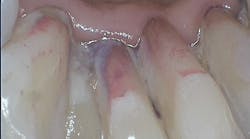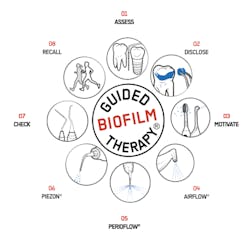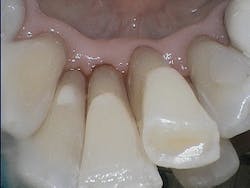Of all the topics I currently lecture on, I believe this is the most revolutionary for clinicians, students, and educators. If the title of this article catches your attention and you are already implementing this system of biofilm management, then you are an early adopter, and it is likely that your patients love the experience. If you are an educator and are teaching guided biofilm therapy (GBT) to your students, your graduates are positioned to be leading-edge professionals when they enter the marketplace. If you aren’t sure exactly what GBT is, I invite you to read further.
GBT denotes a method of biofilm management inclusive of the use of Air-Flow, Perio-Flow, and Piezon technologies (EMS). This systematic, predictable method of biofilm management features the intentional removal of biofilm as a definitive procedure, using low-abrasive powder in a novel air polishing device. Therapy is performed prior to the instrumentation of hard deposits.
You might also be interested in: Understanding dental biofilm and guided biofilm therapy
The term “Guided Biofilm Therapy” was developed by EMS, a company devoted to research and development of novel technologies. I suggest that you not “throw out the baby with the bathwater” and discredit scientific conclusions about the benefits of GBT simply based on its origin. If you wish to review a synopsis of research supporting this method of biofilm management, read “Clinical Evidence for the Air-Flow Perio on Natural Teeth and Implants.” It provides evidence-based studies that paint a picture of managing biofilm differently.
Reversing the order with new technologies
Preservation, patient comfort, and efficiency
As clinicians, we should prevent scratching surfaces or creating mineral loss while removing biofilm, both of which could ultimately leave the surfaces more plaque- or stain-retentive. Flemmig et al. reminded clinicians in a 2007 study that “abrasion on tooth surfaces might become substantial over time, when the cumulative effects of repeated instrumentation during SPT [supportive periodontal therapy] are considered.”1
Low-abrasive powders such as glycine or, most recently, Air-Flow Plus powder with erythritol (both feel similar to talc) have been shown not to leave scratches or create mineral loss. They are remarkably effective in removing biofilm thoroughly when used in an Air-Flow device.2 Low-abrasive powder replaces polishing with rubber cups or brushes and abrasive prophy pastes.
Clinicians traditionally mechanically debride biofilm and calculus simultaneously using repetitive, overlapping strokes followed by polishing pastes. Thirty years ago, there weren’t many other options, but just like the technological advances in dentistry—e.g., digital radiographs, scanning devices to replace alginate impressions, and technology to move teeth with computer-generated trays—GBT is a system that replaces the antiquated methods of professional biofilm management. From a comfort perspective, GBT is ergonomic for the clinician and preferred by patients compared to biofilm management with ultrasonic or hand instrumentation.3
Another benefit of biofilm management via GBT is efficiency when implementing the eight-step system. Since clinicians remove biofilm from surfaces early on in the appointment, the need for overlapping, repetitive strokes using power or hand instrumentation is substantially reduced. Total debridement time is less, which allows extra time for additional services and patient education. The patient experiences less mechanical instrumentation with GBT, yet enjoys the optimal outcome of smooth, clean surfaces.
Why should clinicians make every effort to shift to GBT?
Integration of technologies that save time during the appointment, are safe and comfortable for the patient, and are easy for clinicians to use have multiple benefits—from increased longevity for the practicing clinician, to increased referrals from pleasant patient experiences, to confidence in “doing no harm” on delicate oral surfaces during biofilm removal.
I have implemented this method of biofilm management with my patients since 2012, and it has been the single biggest game changer of any technologies since I began practice in 1979. That is a strong statement, isn’t it? I truly wish all clinicians today practiced GBT. But don’t take my word for it; investigate for yourself. Learn more from global experts at RDH UOR as they unwrap the eight-step GBT system, share their experiences, and challenge you to change the status quo in the way you practice biofilm management.
Editor's note: Originally posted in 2020 and updated regularly
References
1. Flemmig TF, Hetzel M, Topoll H, Gerss J, Haeberlein I, Petersilka G. Subgingival debridement efficacy of glycine powder air polishing. J Periodontol. 2007;78(6):1002-1010. doi:10.1902/jop.2007.060420
2. Drago L, Del Fabbro M, Bortolin M, Vassena C, De Vecchi E, Taschieri S. Biofilm removal and antimicrobial activity of two different air-polishing powders: an in vitro study. J Periodontol. 2014;85(11):e363-369. doi:10.1902/jop.2014.140134
3. Zantello B, Posorski E. Air polishing as an adjunctive therapy. Dimens Dent Hyg. 2019;17(3):41-44.










